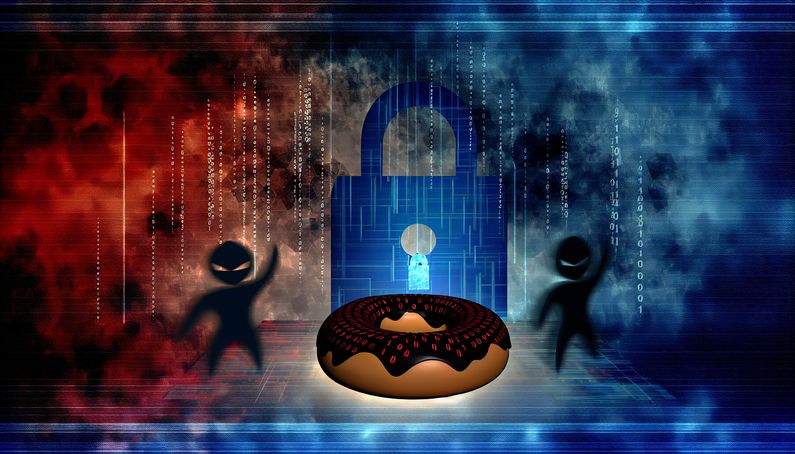
Krispy Kreme Data Breach: Lessons from the Play Ransomware Attack
The Krispy Kreme data breach in November 2024 serves as a stark reminder of the vulnerabilities that even well-established companies face in the digital age. This incident, orchestrated by the notorious Play ransomware group, highlights the sophisticated tactics employed by cybercriminals today. Known for their double-extortion model, the Play group not only encrypts data but also threatens to release it publicly, adding pressure on victims to comply with ransom demands (BleepingComputer). The attack on Krispy Kreme disrupted its digital sales channels, underscoring the critical need for robust cybersecurity measures (Cyber Insider).
The Role of Play Ransomware
Emergence and Modus Operandi
The Play ransomware group, also known as PlayCrypt, emerged in June 2022 and has quickly become a notorious entity in the cybercrime landscape. This group is known for its sophisticated tactics, primarily employing a double-extortion model. This approach involves not only encrypting the victim’s data but also exfiltrating it, which adds pressure on the victim to pay the ransom to prevent the public release of sensitive information. The Play ransomware group has been linked to several high-profile attacks, including those on cloud computing company Rackspace and the City of Oakland in California (BleepingComputer).
Targeting Krispy Kreme
In November 2024, Krispy Kreme became a target of the Play ransomware group. The attack was first detected on November 29, 2024, when unauthorized activity was noticed on Krispy Kreme’s IT systems. The breach was publicly disclosed on December 11, 2024, and by December 19, the Play ransomware group had claimed responsibility for the attack on their dark web leak site (Cyber InfoBlog). The group threatened to release sensitive internal company information if their demands were not met by December 21, 2024 (HackRead).
Impact on Operations
The attack had significant operational impacts on Krispy Kreme, particularly affecting its digital sales channels. While physical stores remained operational, the breach caused disruptions in online ordering systems, which are a crucial component of the company’s revenue stream. This disruption highlighted the vulnerabilities in Krispy Kreme’s cybersecurity infrastructure and the potential financial implications of such attacks (Cyber Insider).
Data Compromised
The Play ransomware group claimed to have stolen a vast amount of data from Krispy Kreme’s network. The allegedly stolen data included private and personal confidential data, client documents, budgetary information, payroll data, accounting records, contracts, tax information, identification documents, and financial information (Daily Security Review). This extensive data theft posed significant risks not only to Krispy Kreme but also to its customers and employees, whose personal information was compromised.
Response and Mitigation Efforts
In response to the breach, Krispy Kreme initiated an immediate investigation and began notifying affected customers of the data exposure. The company filed an incident report with the U.S. Securities and Exchange Commission (SEC) and took steps to mitigate the impact of the breach on its operations (Cyber Insider). Despite these efforts, the breach underscored the need for enhanced cybersecurity measures and the importance of having robust incident response plans in place.
International Links and Implications
Recent reports have linked the Play ransomware group to North Korean state-backed hackers, suggesting potential geopolitical motivations behind their attacks (HackRead). This connection raises concerns about the broader implications of ransomware attacks, as they may be used not only for financial gain but also as tools for state-sponsored cyber warfare. The involvement of state-backed actors in ransomware operations complicates the response and mitigation efforts, as it introduces elements of international diplomacy and cybersecurity policy into the equation.
Lessons Learned
The Krispy Kreme data breach serves as a stark reminder of the evolving threat landscape and the need for organizations to prioritize cybersecurity. The incident highlights the importance of implementing comprehensive security measures, including regular security audits, employee training, and incident response planning. Additionally, it underscores the need for collaboration between the private sector and government agencies to address the growing threat of ransomware attacks and to develop effective strategies for prevention and response.
Future Outlook
As ransomware attacks continue to rise, organizations must remain vigilant and proactive in their cybersecurity efforts. The Play ransomware group’s attack on Krispy Kreme is likely not an isolated incident, and similar attacks can be expected in the future. To mitigate the risk of such attacks, organizations should invest in advanced threat detection and prevention technologies, foster a culture of cybersecurity awareness, and engage in information sharing with industry peers and government entities. By taking these steps, organizations can better protect themselves against the ever-evolving threat of ransomware and safeguard their critical assets and data.
Final Thoughts
The Krispy Kreme data breach is a cautionary tale for businesses worldwide, emphasizing the importance of cybersecurity in protecting sensitive data and maintaining operational integrity. The involvement of the Play ransomware group, potentially linked to state-backed actors, adds a layer of complexity to the threat landscape (HackRead). As organizations navigate these challenges, investing in advanced threat detection and fostering a culture of cybersecurity awareness are crucial steps. Collaborative efforts between the private sector and government agencies can further enhance defenses against such sophisticated attacks (Cyber Insider).
References
- BleepingComputer. (2024). Krispy Kreme says November data breach impacts over 160,000 people. https://www.bleepingcomputer.com/news/security/krispy-kreme-says-november-data-breach-impacts-over-160-000-people/
- Cyber InfoBlog. (2024). Real case analysis #54: Krispy Kreme data breach. https://www.cyberinfoblog.com/blog/real-case-analysis-54-krispy-kreme-data-breach
- HackRead. (2024). Play ransomware Krispy Kreme breach data leak. https://hackread.com/play-ransomware-krispy-kreme-breach-data-leak/
- Cyber Insider. (2024). Krispy Kreme begins notifying customers of data exposure from 2024 ransomware attack. https://www.cyberinsider.com/krispy-kreme-begins-notifying-customers-of-data-exposure-from-2024-ransomware-attack/
- Daily Security Review. (2024). Krispy Kreme breach: Play ransomware gang claims data theft, threatens data leak. https://dailysecurityreview.com/security-spotlight/krispy-kreme-breach-play-ransomware-gang-claims-data-theft-threatens-data-leak/



